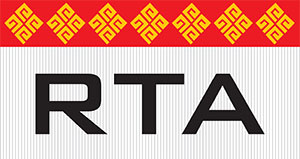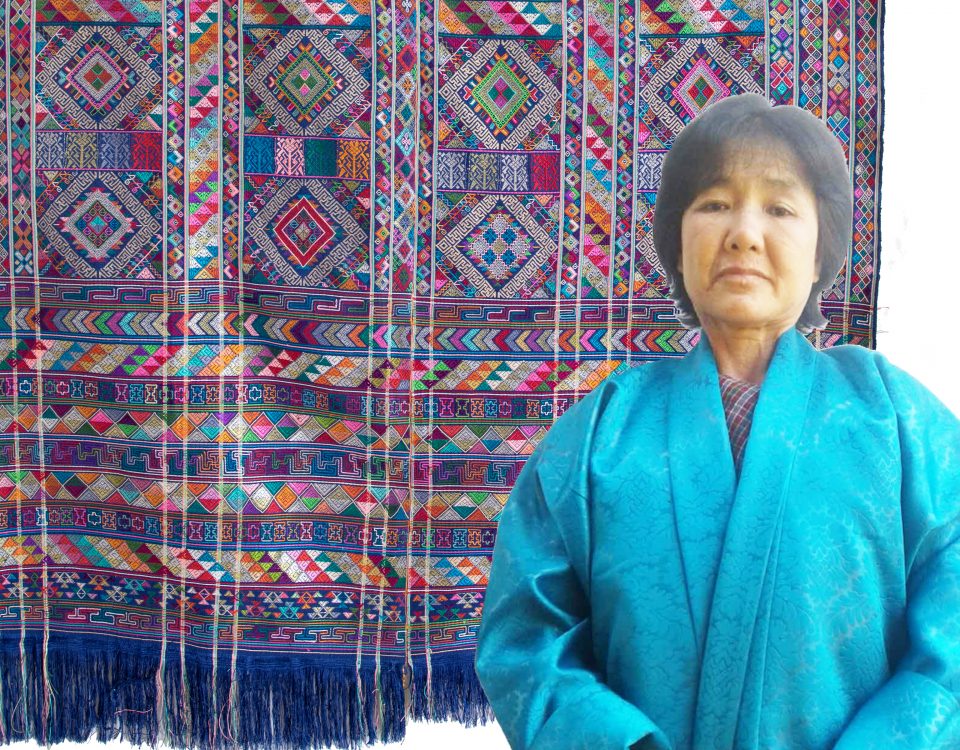Zhabdrung Ngawang Namgyel – the founder of Bhutan
Main story: It’s bright, the main room where the exhibit is carefully placed behind sealed glasses. There is a special aura in the room. Zhabdrung Ngawang Namgyel – the founder of Bhutan – who we read in history books suddenly came alive through the sacred relics and objects displayed at the Royal Textile Academy (RTA) in Thimphu.
Ap Dorji, an old man from Changangkha, throws himself down and prostate on the carpeted gallery floor. He does this three times and gets up, mumbling prayers. His daughter, Sonam Wangmo, accompanies him. With folded hands, Ap Dorji slowly and carefully observes the relics, bowing his head and making small monetary offerings.
To her father, Sonam Wangmo carefully explains every object that is displayed.
There are silk thangkas of Zhabdrung Ngawang Namgyel that dates back to the 17th century and some brought all the way from Tashigang Goenpa in Hongtsho. There is a jacket (kutoe), ceremonial lap cover (chagsi pangkhep) and auspicious hat (uzham) belonging to Chogley Jigme Tenzin, one of his reincarnations.
There is a statue of Dorji Chang or Vajradhara, made of gilt bronze and gold, and a thunderbolt (dorje) and bell (drilbu), made of gilt bronze and brass, which were believed to be have been brought from Ralung in Tibet by Zhabdrung Ngawang Namgyel who presented it to his hostess Zumpo Chungmo in Jarogang during his visit in the 17th century.
There is also a statue of Zhabdrung Ngawang Namgyel made of rice during his departure from Jarogang. It is believed that Zhabdrung modelled two small statues of himself out of rice, and presented it to his hostess Zompu Chungmo. It is believed that one flew away to Dare tsho in Tsirang, which sprouted into a tree signifying his teachings will flourish in the region.
The relics are brought on loan from Jarogang Lhakhang in Wangdue.
 Sacred artefacts belonging to Zhabdrung Ngawang Namgyel such as prayer beads (chag threng) numbering 84 from Semtokha Dzong, and miniature stupas (tsa tsa) and a statue presented by Zhabdrung to Chugpo Lhawang Tshering and his son Druk Tashi during the 17th century brought from Gasa were exhibited. Other artefacts belonging to his reincarnation Chogley Yeshey Ngodrup are also on display.
Sacred artefacts belonging to Zhabdrung Ngawang Namgyel such as prayer beads (chag threng) numbering 84 from Semtokha Dzong, and miniature stupas (tsa tsa) and a statue presented by Zhabdrung to Chugpo Lhawang Tshering and his son Druk Tashi during the 17th century brought from Gasa were exhibited. Other artefacts belonging to his reincarnation Chogley Yeshey Ngodrup are also on display.
Overcoming with emotions, Ap Dorji wiped his tears.
“We are fortunate to be able to witness such sacred relics that are presented here. I’m truly grateful for this opportunity,” Ap Dorji said.
 More locals and tourists streamed in as the curators explained about the artefacts and sacred relics that are being displayed.
More locals and tourists streamed in as the curators explained about the artefacts and sacred relics that are being displayed.
According to a press release issued by the Textile Museum, it states that this would be the first time that such a spiritually significant exhibition has been organised at the RTA.
“This exhibition would not have been possible without the support of Their Majesties The Kings,” the press release states. “The exhibition was initiated under the personal guidance of Her Majesty the Gyalyum Sangay Choden Wangchuck, Royal Patron of the Textile Museum and the Royal Textile Academy.”
 The artefacts showcased in the exhibition are on loan from various private individuals and monastic institutions.
The artefacts showcased in the exhibition are on loan from various private individuals and monastic institutions.
Zhabdrung is highly revered in Bhutan and is regarded as the founder of the country. Zhabdrung, which translates as ‘At whose feet one submits’, is considered to be an emanation of Avalokitesvara, the Buddha of Compassion and the reincarnation of Kuenkhen Pema Karpo, who was the 18th chief abbot of Ralung Monastery in Tibet.
It was in 1616 that Zhabdrung Ngawang Namgyel embarked on his historic journey from Tibet to Bhutan. Bhutan commemorates the 400th year of Zhabdrung’s arrival in Bhutan this year.
 Zhabdrung Ngawang Namgyel founded Bhutan and ruled the country for over 35 years. He passed away in 1651 but his death was concealed for over 54 years under the pretext that he had entered into a strict retreat.
Zhabdrung Ngawang Namgyel founded Bhutan and ruled the country for over 35 years. He passed away in 1651 but his death was concealed for over 54 years under the pretext that he had entered into a strict retreat.
“The exhibition dedicated to Zhabdrung Ngawang Namgyel – the founder of our country bears immense spiritual significance, it bestows blessings and provide a window into the life and legacy of a very important figure in Bhutan’s history,” states the press release.
The exhibition will be open to the public for six months while the second exhibition titled Zhabdrung Ngawang Namgyel – A Biography through Kuthangs – which showcases a pictorial biography, that shows the amalgamation of traditional artistic skills, reverence and gratitude will be open till the end of October this year.
The exhibition is being organised by the Textile Museum, RTA, and the Department of Culture with the home ministry.
Thinley Zangmo
Source: Kuensel





